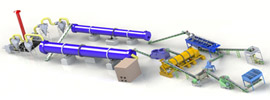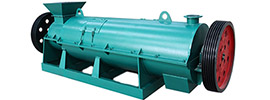Types of Organic Fertilizers Made from Kitchen Waste
Kitchen waste can be scientifically transformed into various organic fertilizers suitable for different planting scenarios and nutrient needs. Below are common types and their specific applications:
1. Basic Compost (Universal Organic Fertilizer)
Raw Materials: Fruit peels, vegetable scraps, tea leaves, coffee grounds, cooked rice/noodles, crushed eggshells, stale bread, etc.
How to Make:
- Layered Composting: Alternate layers of "wet kitchen waste (1 part)" and "dry materials (1 part, e.g., shredded paper, dry leaves)" to maintain airflow.
- Environment Adjustment: Turn the pile weekly to aerate, keep moist (like a wrung-out sponge), and avoid waterlogging.
- Completion: After 2–3 months, the compost turns dark brown, crumbly, and odorless, with original materials unrecognizable.
Features:
- Rich in nitrogen, phosphorus, potassium, and trace elements, suitable for most plants.
- Can be mixed into soil (1:3 ratio) or used as top mulch.
2. Vermicompost (Premium Efficient Fertilizer)
Raw Materials: Kitchen waste suitable for worms (e.g., vegetable scraps, fruit peels, coffee grounds); avoid acidic or spicy foods.
How to Make:
- Worm Bin Setup: Line the bottom with moist coconut coir or newspaper, add red worms (e.g., Eisenia fetida).
- Regular Feeding: Add small amounts of waste at a time, cover with a thin layer of soil or paper, and keep dark and moist.
- Harvest Castings: After 2–3 months, collect worm castings (granular, odorless) from the bin bottom.
Features:
- Gentle fertilizer that won’t burn roots, ideal for seedlings or sensitive plants (e.g., orchids, succulents).
- Rich in humic acid and beneficial microbes, improves soil structure.
3. Bokashi Fertilizer (Rapid Fermentation Fertilizer)
Raw Materials: All compostable kitchen waste + Bokashi bran (containing lactic acid bacteria, yeast, etc.).
How to Make:
- Sealed Fermentation: In a dedicated bucket, layer waste with Bokashi bran, press down, and seal tightly.
- Air Management: Open the lid weekly to release gas. After 2–4 weeks, waste turns into white, tangy mycelium.
- Secondary Maturation: Bury the mycelium in soil or mix with garden soil for 2–3 more weeks.
Features:
- Fast fermentation, suitable for small spaces or emergency fertilizer needs.
- Mycelium can be buried directly in soil, avoiding direct contact with plant roots.
4. Liquid Fertilizer from Kitchen Waste (Quick-Release Nutrient Solution)
Raw Materials: Fresh kitchen waste (e.g., fruit peels, vegetable scraps) + water.
How to Make:
- Fermentation: Fill a sealed bucket with waste, add water to 2/3 capacity, and ferment for 1–2 months.
- Filtration: After fermentation, strain the liquid and dilute 1:10 with water before watering plants.
Features:
- Rich in water-soluble nutrients, ideal for top-dressing or foliar spraying.
- Control odors by adding citrus peels.
5. Specialized Functional Fertilizers (Targeted Nutrient Supplements)
- Eggshell Calcium Fertilizer
- Raw Materials: Cleaned, dried, and crushed eggshells.
- Usage: Mix into soil or soak in water (1 week) for calcium-rich liquid to prevent tomato blossom-end rot.
- Banana Peel Potassium Fertilizer
- Raw Materials: Chopped or dried banana peels.
- Usage: Bury in soil or soak (1:5 ratio) to promote flowering and fruiting.
- Coffee Ground Nitrogen Fertilizer
- Raw Materials: Used coffee grounds (dry or mix with soil before fermentation).
- Usage: Use as top mulch or mix into soil to acidify soil (beneficial for blueberries, azaleas).
6. Fertilizer Recommendations for Different Scenarios
| Plant Type |
Recommended Fertilizer |
Benefits |
| Foliage Plants |
Basic compost + coffee grounds |
Promotes lush, green leaves |
| Flowering/Fruiting Plants |
Vermicompost + banana peel potassium fertilizer |
Enhances blooming and fruit sweetness |
| Succulents/Cacti |
Diluted Bokashi fertilizer |
Gentle nutrient supply, prevents root burn |
| Vegetables |
Basic compost + eggshell calcium fertilizer |
Provides balanced nutrition, prevents calcium deficiency |
Key Notes
- Fully Compost: Uncomposted waste may burn roots or attract pests—ensure complete fermentation.
- Avoid Overuse: Even organic fertilizers can cause soil salt buildup if applied excessively.
- Combine with Chemical Fertilizers: Use organic and synthetic fertilizers together to meet plants’ needs at different growth stages.
By repurposing kitchen waste, you reduce landfill pressure while providing plants with natural, safe nutrients—achieving a sustainable household ecosystem!
 Send us a Email
Send us a Email Wulong Industrial Cluster
Wulong Industrial Cluster Have any question?
Have any question?



















